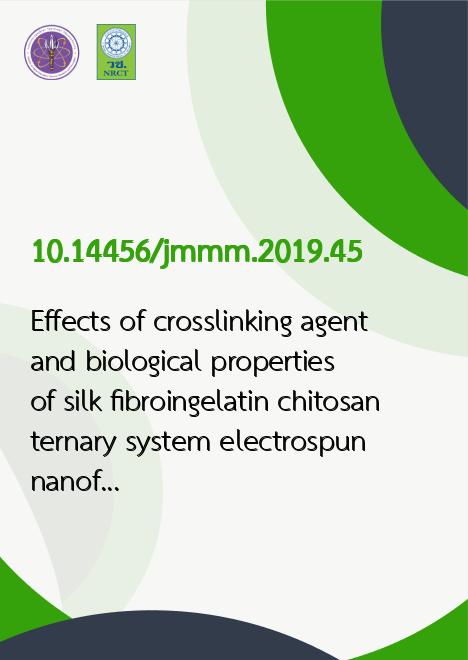
|
Effects of crosslinking agent and biological properties of silk fibroin/gelatin/ chitosan ternary system electrospun nanofiber mats |
|---|---|
| รหัสดีโอไอ | |
| Creator | Pornpen SIRIDAMRONG |
| Title | Effects of crosslinking agent and biological properties of silk fibroin/gelatin/ chitosan ternary system electrospun nanofiber mats |
| Contributor | Narong LUMBIKANANDA, Somporn SWASDISON, Manunya OKHAWILAI, Niyom THAMRONGANANSKUL |
| Publisher | Metallurgy and Materials Science Research Institute Chulalongkorn University |
| Publication Year | 2562 |
| Journal Title | Journal of Metals Materials and Minerals |
| Journal Vol. | 29 |
| Journal No. | 4 |
| Page no. | 34-44 |
| Keyword | Electrospun nanofiber mats, Silk fibroin, Gelatin, Chitosan, Crosslinking agent |
| URL Website | http://ojs.materialsconnex.com/index.php/jmmm/article/view/478 |
| Website title | Effects of crosslinking agent and biological properties of silk fibroin/gelatin/chitosan ternary system electrospun nanofiber mats. | Siridamrong | Journal of Metals, Materials and Minerals |
| ISSN | 8576149 |
| Abstract | In this study, electrospinning technique was used for ternary system to fabricate nanofiber mats from silk fibroin (SF):gelatin (G):chitosan (C) with various mass ratios i.e. 10:20:0, 10:20:0.5, 10:20:1, 10:20:1.5, 10:20:2, and 20:10:1. An increase in chitosan content of the mats was found to decrease average fiber diameter and with narrow size distribution. Tensile strength of SF:G:C nanofiber having greater SF content was lower than that of the fiber mat having lower SF content. The obtained fiber mats were then crosslinked by three different crosslinking agents including ethanol, glutaraldehyde and 1-ethyl-3-(3-dimethylaminopropyl) carbodiimide hydrochloride (EDC)/N-hydroxysuccinmide (NHS). The smooth fiber with high porosity of the nanofiber mat was observed after crosslinked using EDC/NHS agent. A less swollen fiber was noticed in the fiber mats having higher SF content. The results from in vitro study revealed the good cell adhesion and proliferation of gingival tissues. Such results indicated the potential use of SF:G:C nanofiber mats as membrane application. |
